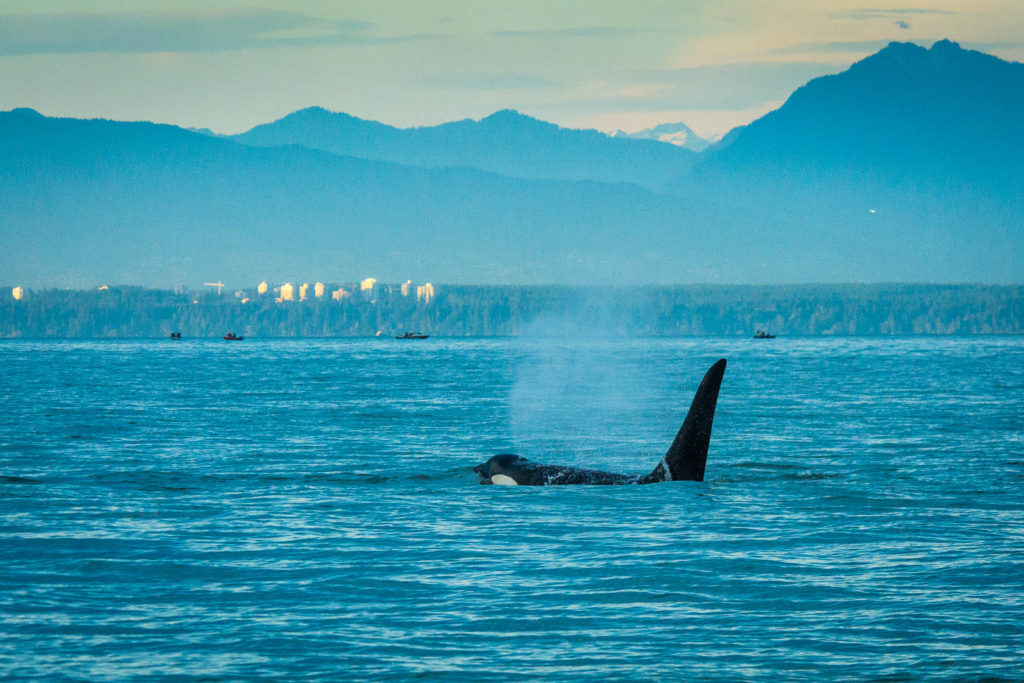No shortage of prey for southern resident killer whales in Canadian waters during summer
October 12, 2021

October 12, 2021

A popular belief that there are fewer Chinook salmon during the summer in Canadian waters for southern resident killer whales, compared to an abundance of fish for northern resident killer whales, has been debunked by a study led by scientists at the University of British Columbia.
In a paper published today in the Canadian Journal of Fisheries and Aquatic Sciences, researchers report that the numbers of Chinook salmon in the Salish Sea in summertime are four to six times more abundant for southern resident killer whales than northern resident killer whales.
"People have been talking about a prey shortage as if it’s a fact, but this is the first study to quantify and compare the amount of their preferred prey, Chinook salmon, available to southern and northern resident killer whales,” said lead author Dr. Mei Sato (she/her), a research associate at the Institute for the Oceans and Fisheries at UBC at the time of the study, and now an assistant scientist at Woods Hole Oceanographic Institution.
While the small southern resident population numbered 73 individuals as of October 2021, the increasing northern resident population numbers around 300. In recent years, southern residents have also been returning later than normal to the inside coastal waters of British Columbia and Washington.
"Measurements from drone footage has shown the southern resident killer whales are thinner on average than the northern residents — which supports the common belief that the southern residents are experiencing a food shortage,” said co-author Dr. Andrew Trites (he/him), professor and director of the Marine Mammal Research Unit (MMRU) at the Institute for the Oceans and Fisheries at UBC. “Our findings suggest that this food shortage is probably not occurring during the summertime when they have traditionally fed in the Salish Sea."
For the study, the team spent the summers of 2018 and 2019 surveying two areas known to be important foraging habitats for resident killer whales — the Johnstone Strait for northern residents and the Juan de Fuca Strait for southern residents — where killer whales intercept migrating Chinook salmon returning to the Salish Sea.
Using state-of-the-art fish finders, the team compared the number and size of Chinook salmon in the two straits.
"We got help from sport and commercial fisherman, chartered fishing vessels and used echosounders to detect the number and size of fishes in the water,” said Dr. Sato. “Killer whales use a similar technique to locate the fish — only it’s much better than the electronic one we use because they can distinguish between different fish species in the water.”
The team collaborated with sport and commercial fisherman, the Sport Fishing Institute of British Columbia, and whale watching companies to design the survey and conduct fish sampling. The collaboration identified the best timing to conduct field work based on peak salmon availability and killer whale foraging behaviour.
The team also captured sample fish to validate the acoustic signals from their fish finder and distinguish between different fish species, as killer whales prefer larger, older Chinook salmon.
They found that while the distribution and sizes of fish were similar in both straits, there were four to six times as many fish in each patch in the Juan de Fuca Strait.
Estimating prey fields for resident killer whales is a tall order, and this is the first study to use acoustic surveys to estimate the relative abundance of large salmons in the Salish sea. Dr. Stéphane Gauthier (he/him), a scientist with Fisheries and Oceans Canada, believes that these measurements should be expanded, and that this study highlights the importance of assessing salmon distribution at sea using hydro-acoustics methods.
While the study looked at the availability of salmon, it did not assess other factors that might prevent the killer whales from catching the fish, such as higher vessel presence and noise in the Juan de Fuca Strait compared to Johnstone Strait.
Now that there is evidence that southern residents are not facing a prey shortage in their traditional summer feeding areas in Canadian waters, Dr. Sato and Dr. Trites agree that the focus of research efforts should be directed to other factors, areas and seasons.
"We don’t really know about prey availability outside of the Salish Sea and outside the summer season. To answer the question of whether there’s an overall prey shortage, we still need to figure out what’s happening during winter and spring, whether there are significant fluctuations year-to-year and in the different locations these whales travel to, like California,” said Dr. Sato.
We honour xwməθkwəy̓ əm (Musqueam) on whose ancestral, unceded territory UBC Vancouver is situated. UBC Science is committed to building meaningful relationships with Indigenous peoples so we can advance Reconciliation and ensure traditional ways of knowing enrich our teaching and research.
Learn more: Musqueam First Nation